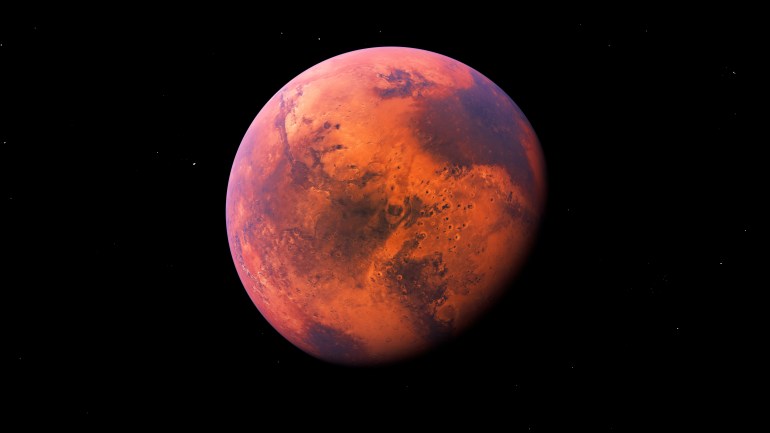Suppose you are an astronaut who has now landed on Mars, what do you need to survive?
According to a report published on "The Conversation", the list can of course be shortened to water, food and shelter, but what we will focus on here is the need for oxygen, so can oxygen be found in the air or environment of Mars so that it facilitates the mission of future astronauts ?
NASA is currently working on the new technologies needed to send humans to Mars.
The air on Mars is 99% less than on Earth (Shutterstock)
Air on Mars
Oxygen is present in the air we breathe here on Earth, produced for us by plants and some types of bacteria, but oxygen isn't the only gas in Earth's atmosphere, it's not even the most abundant gas. about 78%).
You might be wondering if there is more nitrogen in the air, why do we breathe oxygen?
Technically when you breathe in you take in whatever is in the atmosphere, but your body only uses oxygen and gets rid of the rest when you exhale.
The Martian atmosphere is thin, its volume is only 1% of Earth's, meaning that the air on Mars is 99% less than on Earth, partly because the size of Mars is about half the size of Earth, and therefore its gravity is not strong enough to block gases Atmosphere of escape into space.
The most abundant gas in this thin air on Mars is carbon dioxide, of which high concentrations are toxic to us on Earth, but fortunately carbon dioxide, which makes up 96% of the air on Mars, is much less than 1%. of our atmosphere on Earth.
At the same time, Mars contains almost no oxygen, only one-tenth of one percent of the air, which is nearly insufficient for human survival.
If you try to breathe on Mars without wearing a spacesuit that supplies you with oxygen, you will die in an instant;
You will suffocate and boil your blood due to the low atmospheric pressure.
Researchers have not found any evidence of life on Mars due to its very harsh environment (Shutterstock)
Life without oxygen
So far, researchers have not found any evidence of life on Mars due to its very harsh environment, and it is not only the air, as there is very little liquid water on the surface of Mars as well, and the temperatures are incredibly cold. Night (-73) degrees Celsius.
Despite the harsh environment of Mars, we can say that many organisms on Earth live in harsh environments as well. Life has been found in the Antarctic ice, on the ocean floor and miles below the surface of the earth, and many of these places suffer from extremely cold temperatures. Or very hot, from almost no water and little or no oxygen.
Scientists suspect that even if life no longer existed on Mars, it may have existed billions of years ago, when the atmosphere was thicker, when more oxygen was available, large amounts of liquid water existed on the surface and temperatures were warmer.
The search for signs of ancient life on Mars is one of the goals of NASA's Mars Perseverance rover mission, which landed in July of 2020, on the surface of Mars, which is why Perseverance is looking inside the rocks of Mars. Mars for the fossils of organisms that once lived, probably, primitive life like the microbes of Mars.
Bringing 4 astronauts home from Mars needs about 25 tons of oxygen (Shutterstock)
Oxygen production on Mars
Among the seven instruments on board Perseverance is the MOXIE, an amazing device that takes carbon dioxide from the Martian atmosphere and turns it into oxygen.
If the MOXIE device works the way scientists hope, future astronauts will not only make their own oxygen but can use it in the rocket fuel they will need to return to Earth, as oxygen is an important component of most rocket fuels.
NASA estimates that bringing 4 astronauts home from Mars would need about 25 tons of oxygen, and since carrying anything from Earth to Mars is very expensive, and rockets have limited capacity, so every gram counts.
MOXIE is a step towards solving these two problems by producing oxygen on Mars;
It absorbs carbon dioxide from the Martian atmosphere and heats it to temperatures of about 800 degrees Celsius, allowing it to strip the oxygen atoms of the carbon dioxide and then vent the carbon monoxide.
Promising future
The first test of the experiment, which took place on April 20, 2021, produced about 5 grams of oxygen, which is equivalent to about 10 minutes of breathable air for an astronaut.
MOXIE has more work to be done, NASA's Jim Reuter said in a statement published in April 2021, "but the results of this technology are promising as we move toward our goal of seeing humans one day at a time." Mars".
MOXIE can only produce about 10 grams of oxygen per hour, but future oxygen generators could be much larger and remove oxygen atoms from carbon dioxide much faster.
The more oxygen people can produce on Mars, the less they need to get it from Earth, and the easier it will be for astronauts to go there, but even with "homegrown" oxygen astronauts will still need a spacesuit.

